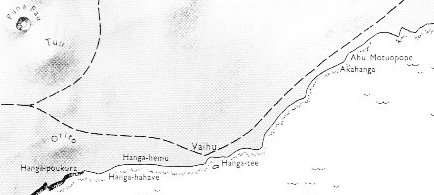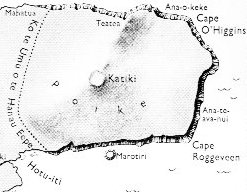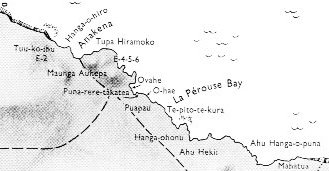The 'sacred geography' of Easter Island, as described in Manuscript E, has the Black Rat (Te Kioe Uri) located on the southern (night) side of the island, between Rano Raraku and Rano Kau:
| Hau Maka had a dream. The dream soul of Hau Maka moved in the direction of the sun (i.e., toward the East). When, through the power of her mana, the dream soul had reached seven lands, she rested there and looked around carefully. The dream soul of Hau Maka said the following: 'As yet, the land that stays in the dim twilight during the fast journey has not been reached.'
The dream soul of Hau Maka countinued her journey and, thanks to her mana, reached another land. She descended on one of the small islets (off) the coast. The dream soul of Hau Maka looked around and said: 'These are his three young men.' She named the three islets 'the handsome youths of Te Taanga, who are standing in the water'.

The dream soul of Hau Maka continued her journey and went ashore on the (actual Easter) Island. The dream soul saw the fish Mahore, who was in a (water) hole to spawn (?), and she named the place 'Pu Mahore A Hau Maka O Hiva'.
The dream soul climbed up and reached the rim of the crater. As soon as the dream soul looked into the crater, she felt a gentle breeze coming toward her. She named the place 'Poko Uri A Hau Maka O Hiva'. The dream soul continued her search for a residence for King Matua. The dream soul of Hau Maka reached (the smaller crater) Manavai and named the place 'Te Manavai A Hau Maka O Hiva'. The dream soul went on and reached Te Kioe Uri. She named the place 'Te Kioe Uri A Hau Maka O Hiva'.
The dream soul went on and came to Te Piringa Aniva. She named the place 'Te Piringa Aniva A Hau Maka O Hiva'. Again the dream soul went on her way and reached Te Pei. She named the place 'Te Pei A Hau Maka O Hiva'. The dream soul went on and came to Te Pou. She named the place 'Te Pou A Hau Maka O Hiva'. The dream soul went on and came to Hua Reva. She named the place 'Hua Reva A Hau Maka O Hiva'. The dream soul went on and came to Akahanga. She named the place 'Akahanga A Hau Maka O Hiva'.

The dream soul went on. She was careless (?) and broke the kohe plant with her feet. She named the place 'Hatinga Te Koe A Hau Maka O Hiva'. The dream soul went on and came to Roto Ire Are. She gave the name 'Roto Ire Are A Hau Maka O Hiva'. The dream soul went on and came to Tama. She named the place 'Tama', an evil fish (he ika kino) with a very long nose (he ihu roroa).

The dream soul went on and came to One Tea. She named the place 'One Tea A Hau Maka O Hiva'. She went on and reached Hanga Takaure. She named the place 'Hanga Takaure A Hau Maka O Hiva'. The dream soul moved upward and came to (the elevation) of Poike. She named the place 'Poike A Hau Maka O Hiva'. The dream soul continued to ascend and came to the top of the mountain, to Pua Katiki. She named the place 'Pua Katiki A Hau Maka O Hiva'.

Everywhere the dream soul looked around for a residence for the king. The dream soul went to Maunga Teatea and gave him the name 'Maunga Teatea A Hau Maka O Hiva'. The dream soul of Hau Maka looked around. From Maunga Teatea she looked to Rangi Meamea (i.e., Ovahe).

The dream soul spoke the following: 'There it is - ho! - the place - ho! - for the king - ho! - to live (there in the future), for this is (indeed) Rangi Meamea.' The dream soul descended and came to Mahatua. She named the place 'Mahatua A Hau Maka O Hiva'. The dream soul continued to look around for a residence for the king. Having reached Taharoa she named the place 'Taharoa A Hau Maka O Hiva'. The dream soul moved along and reached Hanga Hoonu. She named the place 'Hanga Hoonu A Hau Maka O Hiva'.
The dream soul came to Rangi Meamea and looked around searchingly. The dream soul spoke: 'Here at last is level land where the king can live.' She named the place 'Rangi Meamea A Hau Maka O Hiva'. The mountain she named 'Peke Tau O Hiti A Hau Maka O Hiva'. The dream soul moved along a curve from Peke Tau O Hiti to the mountain Hau Epa, which she named 'Maunga Hau Epa A Hau Maka O Hiva'.
The dream soul went to the other side of the mountain Hau Epa. As soon as the dream soul looked around, she saw the sand (beach), which was very white and light. She remained there and explored everything. After she had looked around carefully, the dream soul of Hau Maka said, 'Ah! This is the place that will serve as a residence for the king. She named the place 'Oromanga A Hau Maka O Hiva' and also named the neighboring bay 'Hanga Moria One A Hau Maka O Hiva'.
The dream soul stepped forth lightly and reached Papa O Pea. She carefully looked around for a place where the king could settle down after his arrival and gather his people around (? hakaheuru). Having assembled his people (?) and having come down, he would then go from Oromanga to Papa O Pea, so went the speech of the dream soul. She named the place 'Papa O Pea A Hau Maka O Hiva'.
She then hastened her steps toward Ahu Akapu. There she looked again for a residence of the king. Again the dream soul of Hau Maka spoke: 'May the king assemble his people (?) and may he come in the midst of his people from Oromanga to Papa O Pea. When the king of Papa O Pea has assembled his people (?) and has come to this place, he reaches Aha Akapu. To stay there, to remain (for the rest of his life) at Ahu Akapu, the king will abdicate (?) as soon as he has become an old man'. She named the place 'Ahu Akapu A Hau Maka O Hiva'. The (entire) land she named 'Te Pito O Te Kainga A Hau Maka O Hiva'.
The dream soul turned around and hurried back to Hiva, to its (Home)land, to Maori. She slipped into the (sleeping) body of Hau Maka, and the body of Hau Maka awakened. He arouse and said full of amazement 'Ah' and thought about the dream ... |
I worked much with these stations of the kuhane (dream soul) of Hau Maka. She went along the southern coast before she turned towards the north and then back again along the northern coast. This path, I suggested, represented a journey in timespace, from the early days of the Sun King to where he would abdicate 'as soon as he has become an old man'.
Leaving the first station of the kuhane aside (the 3 islets) as belonging in a 'previous cycle' my first attempt resulted in an order based on 3 groups of 8 stations followed by 3 special cases:
|
1 |
Te Pu Mahore |
9 |
Akahanga |
17 |
Maunga Teatea |
|
2 |
Te Poko Uri |
10 |
Hatinga Te Kohe |
18 |
Mahatua |
|
3 |
Te Manavai |
11 |
Roto Iri Are |
19 |
Taharoa |
|
4 |
Te Kioe Uri |
12 |
Tama |
20 |
Hanga Hoonu |
|
5 |
Te Piringa Aniva |
13 |
One Tea |
21 |
Rangi Meamea |
|
6 |
Te Pei |
14 |
Hanga Takaure |
22 |
Peke Tau O Hiti |
|
7 |
Te Pou |
15 |
Poike |
23 |
Maunga Hau Epa |
|
8 |
Hua Reva |
16 |
Pua Katiki |
24 |
Oromanga |
|
24 * 15 = 360 |
|
25 |
Hanga Moria One |
26 |
Papa O Pea |
27 |
Ahu Akapu |
|
residence of the current king |
residence for the future king |
residence for the abdicated king |
|
28 Te Pito O Te Kainga |
|
28 * 15 = 420 (= 7 * 60 = 6 * 70) |
Later I decided there was an alternative with also the first 2 stations on the island proper as special:
|
1 |
Te Manavai |
8 |
Hatinga Te Kohe |
15 |
Maunga Teatea |
|
2 |
Te Kioe Uri |
9 |
Roto Iri Are |
16 |
Mahatua |
|
3 |
Te Piringa Aniva |
10 |
Tama (*) |
17 |
Taharoa |
|
4 |
Te Pei |
11 |
One Tea (†) |
18 |
Hanga Hoonu |
|
5 |
Te Pou |
12 |
Hanga Takaure |
19 |
Rangi Meamea |
|
6 |
Hua Reva |
13 |
Poike |
20 |
Peke Tau O Hiti |
|
7 |
Akahanga (†) |
14 |
Pua Katiki |
21 |
Maunga Hau Epa |
|
22 |
Oromanga |
23 |
Hanga Moria One |
24 |
Papa O Pea |
25 |
Ahu Akapu |
|
birthplace of the new king |
residence of the current king |
residence for the future king |
residence for the abdicated king |
|
26 Te Pito O Te Kainga |
Anyhow we can see that Te Kio(r)e Uri was at a quite early stage of the Sun King's voyage around his 'island'. Manuscript E has kioe instead of kiore and Te Kioe Uri will therefore only allude to the idea of a black rat (kiore uri).
Instead the basic meaning could be that of a fugitive in a cave:
| Kio 1. Defeated; one who has taken refuge in a house or in a cave. 2. To come out a winner, to win, to be victorious in war, in a quarrel, in a race: ku-kio-á te taûa i a Miru, the war was won by the Miru; ku-kio-á te toru vaka, the third boat won. Kiokio, to smell of smoke, to smell smoky (of food). Vanaga.
1. Stick wherewith to rake things into a heap. 2. Slave, servant, inferior, of low estate, husbandsman. Hakakio, to enslave, to reduce to subjection; tagata hakakio, master. Mgv.: kio, a servant, slave, tiller of the soil. 3. To discourage; also kioa. Kiokio, foul smelling smoke. Mgv.: kio, kiohe, to extinguish, to put out a light. 4. Pau.: kiokio, to chirp. Mgv.: kio, id. Ta.: ioio, to cry, said of a baby. Mq.: kiokio, to chirp. Sa.: 'io, id. Ha.: ioio, id. 5. Mgv.: kio, little, small, said of birds and animals. Mq.: kio, young of birds. 6. Mgv.: kiokio, a fish. Mq.: kiokio, id. 7. Mq.: kio, said of women and children who run away to the mountain shelters in time of war. Ha.: kio, to flee, to hasten away in fear. Churchill.
Hakakio, festival of thanksgiving |
I think the little new one needed help to get going from his people who had gathered at Te Piringa Aniva: ... 1. Hanga Te Pau, the landing site of Ira and his band of explorers, is the natural anchorage for those approaching Vinapu by sea. The remarkable stone fronts of the ahu of Vinapu are all facing the sea. The explorers landed at Hanga Te Pau during the month 'Maro', that is, June ...
2. The cult place of Vinapu is located between the fifth and sixth segment of the dream voyage of Hau Maka. These segments, named 'Te Kioe Uri' (inland from Vinapu) and 'Te Piringa Aniva' (near Hanga Pau Kura) flank Vinapu from both the west and the east. The decoded meaning of the names 'the dark rat' (i.e., the island king as the recipient of gifts) and 'the gathering place of the island population' (for the purpose of presenting the island king with gifts) links them with the month 'Maro', which is June. Thus the last month of the Easter Island year is twice connected with Vinapu. Also, June is the month of summer solstice [a mistake: south of the equator it is winter solstice], which again points to the possibility that the Vinapu complex was used for astronomical purposes.
3. On the 'second list of place names', Hanga Te Pau is called 'the middle (zenith) of the land' (he tini o te kainga). This may refer to a line bisecting the island, but it can just as easily mean the gathering of a great number (of islanders). The plaza (130 x 130 meters) would have been very well suited for this purpose.
4. The transformation of the 'second list of place names' into a lunar calendar links Hanga Te Pau and Rano Kau. A similar linkage occurs in connection with the third son of Hotu Matua between the 'pebbles of Hanga Te Pau' and his name 'Tuu Rano Kau'. There can be no doubt that Vinapu was dependent on the economic resources of the large crater ...
In other words, the list of kuhane stations which basically has 29 stations (counting both the small islets at the beginning and the whole island at the end) first shrank to 28 after excluding the small islets, then to 26 after also separating Te Pu Mahore and Te Pu Mahore.
Finally the number could become only 23 (or 22 if the whole island - the origin like zero - should not be enumerated) and given that Te Manavai, Te Kioe Uri, and Te Piringa Aniva were special cases.
|
1 Te Manavai |
2 Te Kioe Uri |
3 Te Piringa Aniva |
|
4 |
Te Pei |
10 |
Tama (*) |
16 |
Mahatua |
|
5 |
Te Pou |
11 |
One Tea (†) |
17 |
Taharoa |
|
6 |
Hua Reva |
12 |
Hanga Takaure |
18 |
Hanga Hoonu |
|
7 |
Akahanga (†) |
13 |
Poike |
19 |
Rangi Meamea |
|
8 |
Hatinga Te Kohe |
14 |
Pua Katiki |
20 |
Peke Tau O Hiti |
|
9 |
Roto Iri Are |
15 |
Maunga Teatea |
21 |
Maunga Hau Epa |
|
22 |
Oromanga |
23 |
Hanga Moria One |
24 |
Papa O Pea |
25 |
Ahu Akapu |
|
birthplace of the new king |
residence of the current king |
residence for the future king |
residence for the abdicated king |
|
26 Te Pito O Te Kainga |
|




